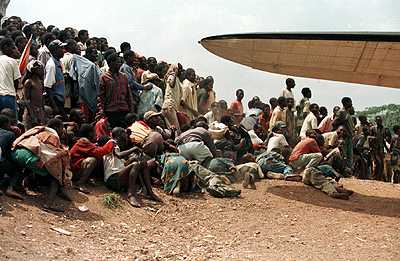The Guardian
05/11/07
 The United Nations is preparing to send a 16-strong team into the Democratic Republic of the Congo to map human rights abuses, 11 years after 200,000 refugees disappeared and following a continental war that has cost the lives of an estimated four million people.
The United Nations is preparing to send a 16-strong team into the Democratic Republic of the Congo to map human rights abuses, 11 years after 200,000 refugees disappeared and following a continental war that has cost the lives of an estimated four million people.
The Office of the High Commissioner for Human Rights has been given $2.3m (£1.1m) to conduct a three-month investigation to map 'the most serious violations of human rights and international humanitarian law committed within the territory of the DRC between March 1993 and June 2003'
The worst killing is believed to have occurred when the Rwandan army, under the surrogate Congolese rebel leader Laurent Kabila, drove Mobutu Sese Seko from power in 1997 while exacting revenge for the 1994 genocide.
'A lot of people went into the forest and were never heard from,' said Reed Brody of Human Rights Watch, who had been part of an earlier, failed attempt to determine how many died and who killed them.
The document the new UN team has put together suggests perpetrators of war crimes may be brought to justice, listing its objectives as assessing 'the existing capacities within the national justice system to deal with such human rights violations as may be uncovered'.
The greatest atrocities appear to have been in 1997. The refugees, Hutus from Rwandan and Burundi, many of them women and children, had been in the vast camps that grew up on the Rwandan border after the genocide in June 1994. These camps were riven with the perpetrators of genocide, driven from their country after they had attempted to annihilate their Tutsi neighbours.
When the killers in the camps continued to raid across the border, the Tutsi-led Rwandan Patriotic Front, which had ended the genocide in 1994, invaded.
Although many of the 1.2 million refugees returned to Rwanda, hundreds of thousands fled into the interior.
Three massacres have been widely recorded. One was outside the regional capital of Kisangani, where witnesses say thousands of Hutu refugees were killed on a railway line, their bodies cremated in a disused quarry before the ashes were dropped into the Congo river. The second was at a town called Mbandaka in the north, where up to 2,000 refugees were caught trying to cross into neighbouring Congo Brazzaville and were cut down in front of the town's population.
'A soldier brought an eight-month-old baby so we could bury him,' said a Red Cross worker. 'But we said, "We can't bury someone living". He took a stick and he hit the child on the head until he was dead.' Then, in September 2005, three mass graves were found to the north of Goma.
As we report in the accompanying film, another mass killing appears to have occurred in the town of Shabunda in South Kivu, in camps that had formed by the river and at a Bailey bridge north of the town.
'The UN was guilty of negligence amounting almost to complicity in this counter-genocide,' said Jasper Elgood, who worked for the aid agency Merlin. 'The UN proclaimed that any refugees who declined to be repatriated would be assumed to be guilty of war crimes.'
Another western aid worker, who still operates in the area, made the bitter comment: 'To this day I have a hard time stomaching the Rwandan genocide propaganda and those who hold up the current regime as a model for all of central Africa.'
An initial attempt to map the sites late in 1997 failed because of interference from Laurent Kabila's government. The UN say that the current government, run by his son Joseph, fully supports this new effort.
A spokesman for Human Rights Watch, the only organisation to compile a report so far, said: 'We support this move as a necessary step towards establishing accountability for some terrible war crimes in eastern Congo that involved hundreds of thousands of people.'
The Guardian
